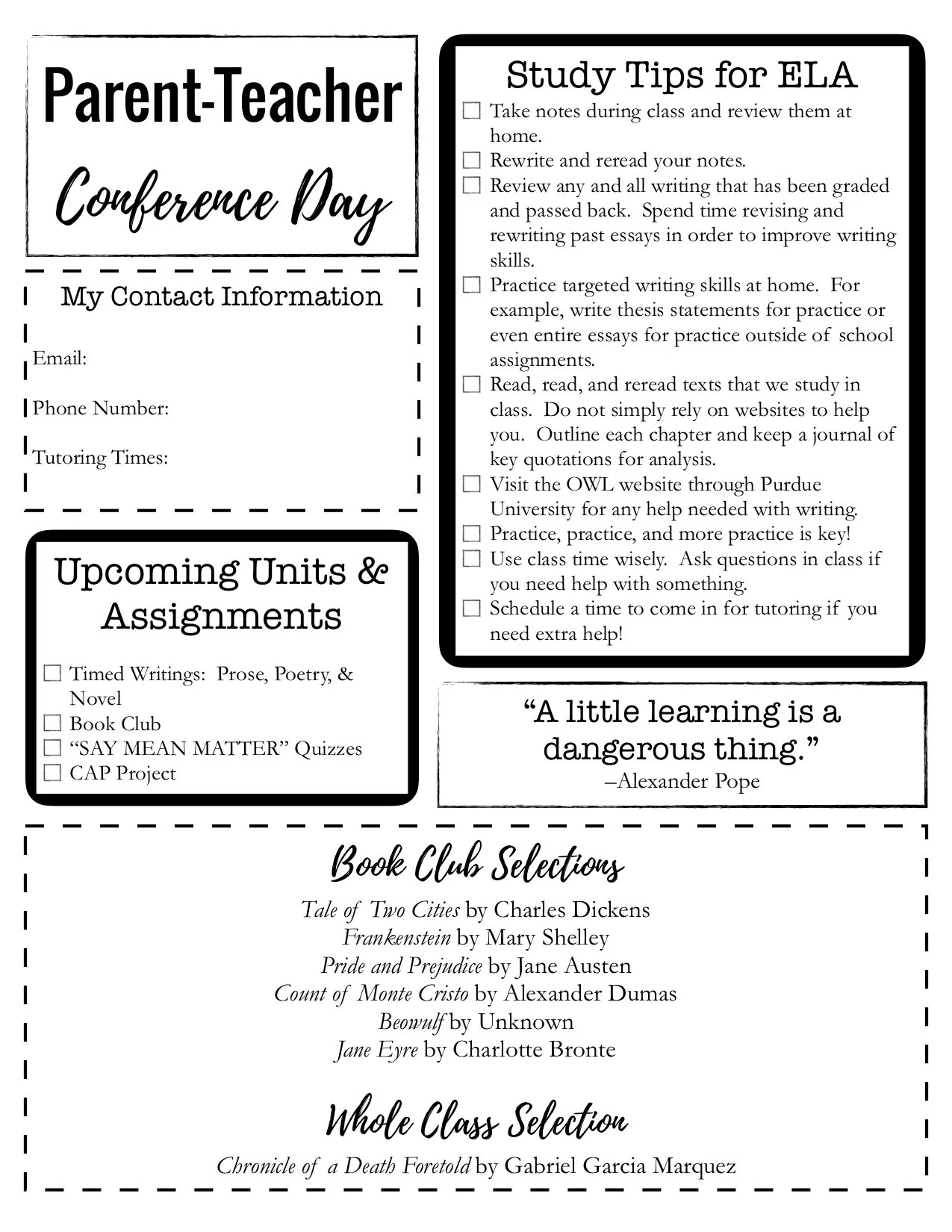Parent-Teacher Conference Day always comes much faster than I expect. Sometimes, I have several parents and students attend, and other years, I may have just a few. However, I always prepare for a large crowd (especially at the secondary level), and the more preparation I can do ahead of time, the smoother my conferences will go. After teaching for ten plus years at this point, I can anticipate the kind of questions that parents and students will have:
Why does my child have X grade?
How can my child improve?
Can my child still pass? How?
How can my child do better (even if the student has an A)?
What are you working on next?
Are you going to do any SAT or ACT prep in class?
What are the required readings for the rest of the year?
Should my child be allowed to spend time playing video games?
Since I know the kind of questions parents will ask, it enables me to prepare ahead of time. Here are three tips to make parent-teacher conferences more efficient and effective while addressing key concerns.
Common Questions Slideshow or Handout
If you do your conferences in a classroom with a waiting area outside of your door, you can take advantage of this “wait” time by creating a slideshow (or handout) that answers many of these key questions. For example, you can create an animated PowerPoint presentation that plays on a loop and put it on display outside of your door. Parents (and students) can watch this slideshow while they wait. Alternatively, you can create a handout with the same information on it for parents to pick up and read while they wait. Front-loading information before the conference can cut down on the actual time spent in the conference. You can find a sample handout template to use in your classes in the Bespoke ELA Freebie Library! Subscribe today to unlock the freebie library by clicking here.
Google Form
If you are 1:1 in your classroom, consider allowing parents to use your laptops. Have a few set up with a Google Form (and instructions) for parents to fill out while they wait. They can submit their answers to you before coming into the conference, and you can pull up their answers and use them as a tool to guide the conversation. Consider asking them about their concerns and questions they may have, and when you open up their submission for the conference, you can go one-by-one through their questions and comments so that the conference is targeted and efficient. You can find a sample Google Form to use by clicking here. This form is not editable but gives you a basic idea of how to use a Google Form for your conferences.
Flipped Conferences
Just like we can flip the classroom, we can flip conferences as well. This means having the conference be student-led instead of teacher-led. Require that students attend the parent-teacher conference, and put the focus on the student to lead it by explaining why they have the grade they do and how they think they can do better. This holds the student accountable, and students on the secondary level should be held responsible for their own work (or lack thereof). You can have students prep for the conference in class by having them fill out a reflection form to bring to the conference— or you can take them up and have them ready to go when the student arrives at the conference with the parent. I think that we burn ourselves out as teachers by doing more work than our students, and that’s not how it should be. The student should be doing most of the work— and that starts with releasing control of small things like parent-teacher conferences and allowing the student to be the one who carries the responsibility. With this idea, consider sending home a letter to parents to explain how the process will work and that it is important to allow the student “room” to lead the conference instead of the teacher or parent. This will help communicate expectations so that the conferences run more smoothly.
Parent-Teacher Conference Day is part of our reality as teachers and provides both parents and students the opportunity to touch base with us about progress and grades. These three tips can help make that process more efficient and effective.
What other tips would you add to this list? How do you organize your conferences?
About the Author
Meredith is the founder and creator of TeachWriting.org and Bespoke ELA. She has taught high school English for 10+ years in Dallas, Chicago, and New York City and holds a M.A. in Literature from Northwestern University. She has always had a connection to the written word-- through songwriting, screenplay writing, and essay writing-- and she enjoys the process of teaching students how to express their ideas. An avid tea drinker and anglophile, Meredith enjoys life with her husband, daughter, and sweet pups.





